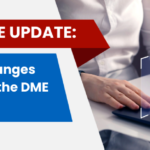Healthcare Common Procedure Coding System (HCPCS) codes are crucial for Durable Medical Equipment (DME) providers to ensure accurate billing and reimbursement. This comprehensive guide will explore the specific HCPCS code ranges most relevant to DME providers, offering insights, examples, and best practices for each.
HCPCS Level II Codes: An Overview
HCPCS Level II codes are alphanumeric and primarily used for products, supplies, and services not included in the CPT codes. For DME providers, understanding these codes is essential for proper billing and reimbursement.
A Codes (A0021-A9999): Transportation Services, Medical and Surgical Supplies
Overview:The codes cover a wide range of items, including transportation services and many medical and surgical supplies used in DME.
Key Sections for DME:- A4000-A4999: Surgical Supplies
- A5000-A5999: Urological Supplies
- A6000-A6999: Wound Dressings

- A4233: Replacement battery, alkaline (other than J cell), for use with medically necessary home blood glucose monitor owned by patient, each
- A5500: For diabetics only, fitting (including follow-up), custom preparation and supply of off-the-shelf depth-inlay shoe manufactured to accommodate multi-density insert(s), per shoe
- Mistaking similar supplies within the A code range
- Not specifying the correct quantity for supplies
B Codes (B4000-B9999): Enteral and Parenteral Therapy
Overview:B codes are used for enteral and parenteral nutrition supplies and equipment.
Key Sections for DME:- B4034-B9999: Enteral and Parenteral Therapy

- B4035: Enteral feeding supply kit; pump fed, per day, includes but not limited to feeding/flushing syringe, administration set tubing, dressings, tape
- B9002: Enteral nutrition infusion pump, any type
- Confusing enteral and parenteral supply codes
- Incorrect coding for daily vs. monthly supply quantities
E Codes (E0100-E8002): Durable Medical Equipment
Overview:E codes are the primary code range for most DME items.
Key Sections for DME:- E0100-E0199: Canes, Crutches, Walkers, Commodes
- E0200-E0299: Phototherapy Systems, Massage Devices, Pneumatic Compressors
- E0300-E0399: Hospital Beds, Accessories, and Repair
- E0400-E0499: Oxygen and Related Respiratory Equipment
- E0500-E0899: Various DME (including wheelchairs, infusion pumps, etc.)

- E0143: Walker, folding, wheeled, adjustable or fixed height
- E0601: Continuous positive airway pressure (CPAP) device
- Not distinguishing between rental and purchase codes
- Overlooking required modifiers for certain E codes
K Codes (K0001-K0899): Temporary Codes for DME Regional Carriers
Overview:K codes are often used for wheelchairs and related accessories.
Key Sections for DME:- K0001-K0108: Wheelchairs and Accessories

- K0001: Standard wheelchair
- K0108: Wheelchair component or accessory, not otherwise specified
- Using K codes when a more specific E code exists
- Not providing sufficient documentation for K0108 (miscellaneous code)
L Codes (L0100-L9900): Orthotic and Prosthetic Procedures
Overview:L codes cover orthotic and prosthetic devices and procedures.
Key Sections for DME:- L0100-L4999: Orthotic Devices and Procedures
- L5000-L9900: Prosthetic Procedures

- L0120: Cervical, flexible, non-adjustable, prefabricated, off-the-shelf (foam collar)
- L5700: Replacement, socket, below knee, molded to patient model
- Confusing similar orthotic or prosthetic codes
- Not specifying laterality (left, right, or bilateral) when required
V Codes (V2020-V2799): Vision Services
Overview:While less common for general DME providers, V codes may be relevant for those dealing with vision-related equipment.
Key Sections for DME:- V2100-V2799: Vision Services

- V2100: Sphere, single vision, plano to plus or minus 4.00, per lens
- V2600: Hand held low vision aids and other non spectacle mounted aids
- Using V codes for non-vision related DME
- Not specifying the correct type of lens or vision aid
Best Practices for DME Providers
- Always use the most specific code available for the equipment or supply.
- Regularly review and update your coding practices as HCPCS codes are updated annually.
- Ensure proper documentation to support the use of each code.
- Be aware of any local coverage determinations (LCDs) that may affect coding and reimbursement.
- Implement a quality assurance process to review coding accuracy.
How WWS Can Help
Navigating the complex world of HCPCS coding can be challenging for DME providers. This is where WWS (Wonder Wizards of Support) comes in, offering comprehensive solutions to streamline your coding processes and maximize reimbursements.
Expert Coding Support
WWS provides access to a team of certified coding specialists with extensive experience in DME billing. Our experts stay up-to-date with the latest HCPCS code changes and can assist with:
- Code selection and verification
- Documentation review to ensure code justification
- Guidance on proper use of modifiers
- Resolution of complex coding scenarios
Advanced Technology Solutions
WWS leverages cutting-edge technology to enhance coding accuracy and efficiency:
- AI-powered code suggestion tools
- Integrated coding and billing platforms
- Real-time code verification systems
- Automated code update alerts
Comprehensive Training and Education
To empower your team, WWS offers:
- Customized HCPCS coding workshops
- Regular webinars on coding updates and best practices
- Access to a vast library of coding resources and guides
- One-on-one coaching sessions for your billing staff
Audit Support and Compliance
WWS helps you maintain coding compliance and prepare for audits:
- Regular internal coding audits
- Assistance with external audit preparation
- Development of coding compliance policies and procedures
- Guidance on responding to audit findings and appeals
Reimbursement Optimization
By leveraging WWS’s expertise and technology, you can:
- Reduce claim denials due to coding errors
- Improve clean claim rates
- Accelerate reimbursement timelines
- Identify opportunities for legitimate reimbursement maximization
Customized Solutions
WWS understands that each DME provider has unique needs. We offer:
- Tailored coding solutions based on your specific product lines
- Scalable services to match your business growth
- Integration with your existing systems and workflows
- Ongoing support and consultation
Getting Started with WWS
Taking the first step towards optimizing your HCPCS coding process is easy:
- Schedule a free consultation with our DME coding experts
- Receive a personalized assessment of your current coding practices
- Get a customized plan tailored to your specific needs and goals
- Begin implementation with our dedicated support team
By partnering with WWS, you can transform HCPCS coding from a challenging task into a strategic advantage for your DME business. Our comprehensive support ensures that you stay ahead of coding changes, maintain compliance, and maximize your reimbursements.
Don’t let coding complexities hold your business back. Contact WWS today to discover how we can elevate your DME coding and billing processes to new heights of accuracy and efficiency.
References and Further Reading:
- CMS.gov HCPCS release page http://cms.gov/
- Official PDAC website for code verifications https://dmepdac.com/palmetto/PDACv2.nsf/T/DME%20Coding%20System%20(DMECS)%20Information
- Relevant medical coding association websites http://aapc.com/



